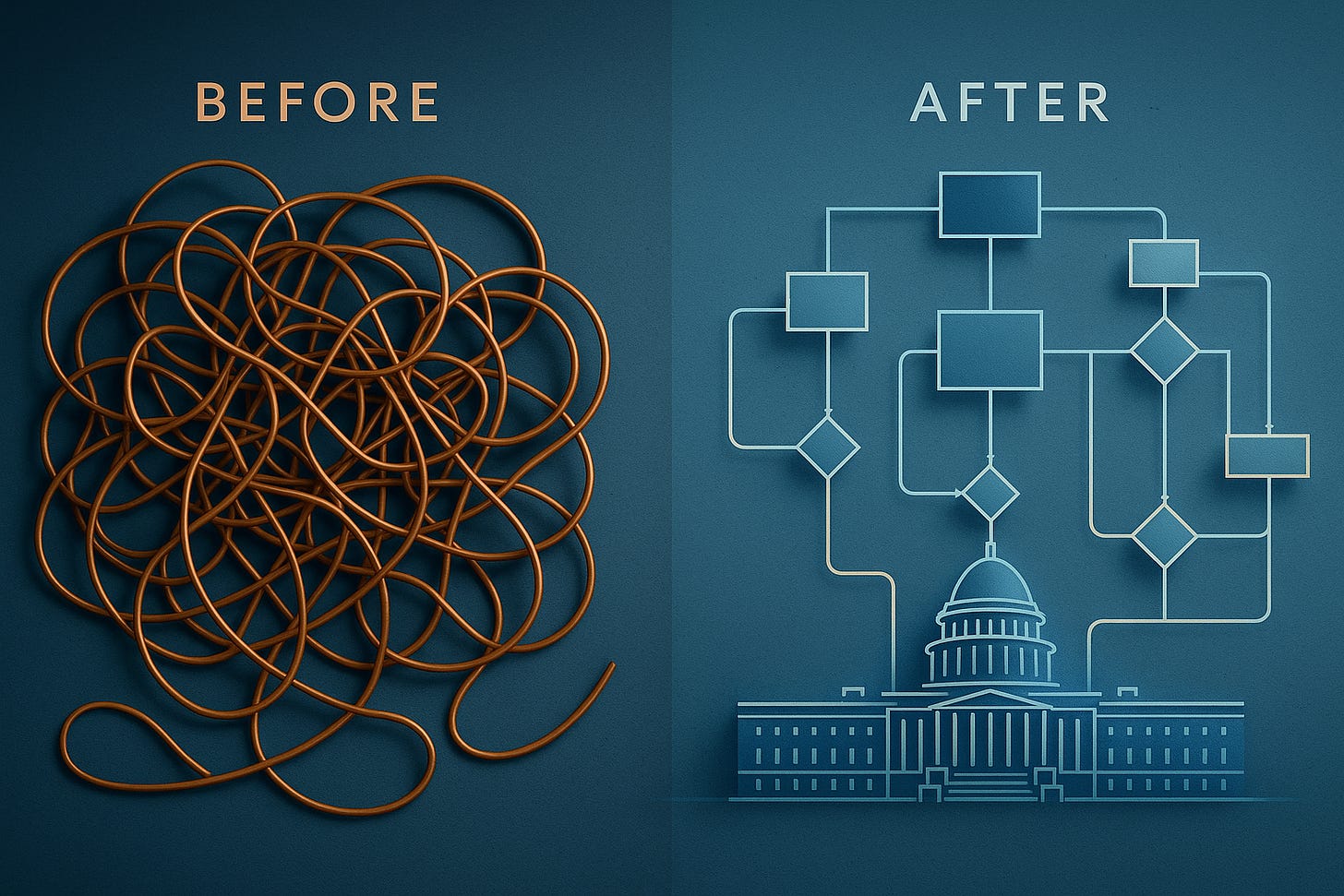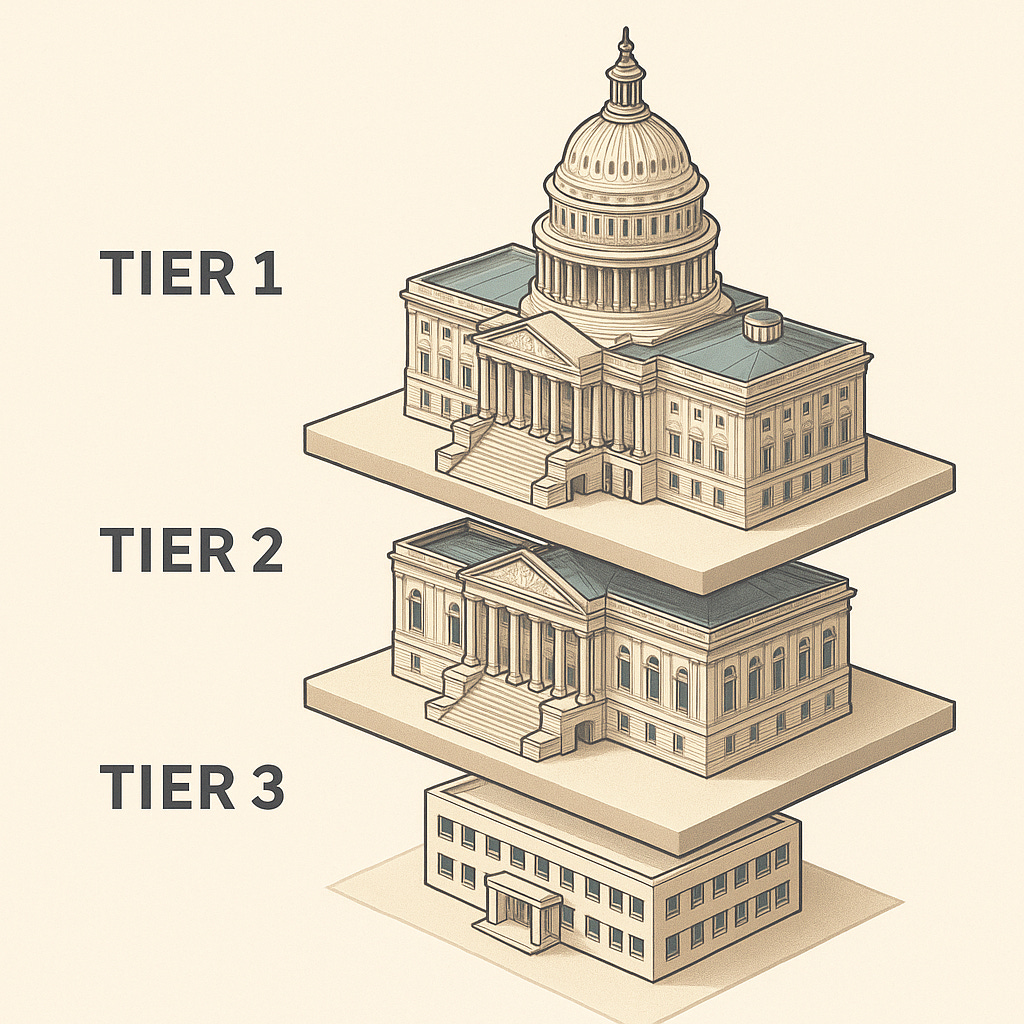Refactoring Government: Why America Needs Governance Architects
P1.2.1 A proposal for fixing what’s broken without fighting over what government should do
The federal government shut down again in 2025. Before that, 2018–2019. Different moments, same dysfunction. Different crises, same structural failure.
When it ends—and it will, through some last-minute patch that solves nothing—we’ll breathe our collective sigh of relief. We’ll celebrate that government is “working again.” Then we’ll wait for the next one.
This isn’t normal. It shouldn’t be acceptable. And it’s time to acknowledge an uncomfortable truth: the people who benefit from broken governmental procedures are the same people who would have to fix them.
That’s not a conspiracy. It’s a conflict of interest built into the system.
The Problem: Players Making the Rules
Imagine a basketball team rewriting the rulebook mid-game. Changing what counts as a foul. Deciding who shoots free throws. Altering the clock when they’re losing.
You’d call it corrupt. Unfair. Absurd.
Yet that’s how our government operates. Congress writes its own rules. The President shapes executive procedures. Courts define their own jurisdictions. Each branch designs the system it operates within, with minimal external oversight.
Sometimes this works. Often it doesn’t. And when it fails—shutdowns, debt ceiling standoffs, confirmation gridlock, legislative paralysis—we have no mechanism to fix it. The only people who could fix it are the ones who benefit from leaving it broken.
This is structural, not personal. You can’t fix it by electing different people. You can’t shame it away with better norms. You need to redesign the architecture.
The Core Insight: How vs. What
Here’s where it gets interesting. Most political debates are about what government should do: healthcare policy, immigration, taxes, foreign intervention, regulation. These are legitimate disagreements. People have different values. Democracy hashes this out.
But there’s a separate question we’ve ignored: How should government operate?
We fight endlessly over policy, but the machinery that implements policy hasn’t been meaningfully updated in generations.
How should Congressional committees be structured?
What’s the optimal budget process?
How should agencies coordinate?
What’s the best confirmation process?
How should government measure performance?
These aren’t ideological questions. They’re design questions. Engineering problems. And they’re being “solved” by politicians whose incentives are completely misaligned with good design.
Software engineers have a term for this: refactoring. Change how the code works while keeping what it does constant. Improve the implementation without changing the functionality.
We need to refactor government.
The Solution: Governance Architects
The idea is simple but profound: separate the design of government from its operation.
Create a professional body—the Federal Governance Agency—whose sole job is to study and optimize how government functions. Not what policies it pursues. Not which laws it passes. Just how the machinery operates.
Think of it as adding a fourth layer:
Current System:
Legislative branch makes laws
Executive branch enforces laws
Judicial branch interprets laws
All three design their own procedures
Proposed System:
Legislative branch makes laws
Executive branch enforces laws
Judicial branch interprets laws
Governance Agency designs how all operate
This isn’t a “fourth branch” wielding direct power. It’s more like a Federal Reserve for government operations: professional, credentialed, semi-independent, providing expertise Congress and the President lack.
What Governance Architects Would Actually Do
The Federal Governance Agency would have a clear, bounded mandate:
They CAN design and recommend:
Congressional procedures and committee structures
Agency organizational frameworks
Budget process reforms
Electoral system mechanics
Regulatory frameworks
Interagency coordination
Government technology systems
Performance measurement
They CANNOT:
Make laws or policy
Determine spending levels
Set foreign policy
Make enforcement decisions
Override Constitutional provisions
Create new powers (only reorganize existing ones)
The test: “Does this change how government operates, or what government does?”
If “how,” it’s their domain. If “what,” it belongs to elected officials.
Making It Real: Structure and Safeguards
For this to work, the Governance Agency needs legitimacy, expertise, and independence.
Legitimacy comes from Constitutional establishment. This requires an amendment—a big lift, but necessary. You can’t fix structural gaps with mere legislation.
Expertise comes from making this a real profession:
University programs in Governance Science
Professional certifications (like CPAs or engineers)
Research infrastructure studying institutional design
Cross-disciplinary training: economics, history, systems theory, data science, software architecture
Independence comes from structural design:
Leadership appointed across branches (President, Congress, professional associations)
Long, staggered terms (10-14 years) insulated from political cycles
Protected funding not subject to annual appropriations
Strong transparency (all research and recommendations public)
“Choose your path” restrictions (can’t serve in governance AND run for office)
Most importantly: They design, Congress decides.
Here’s the mechanism:
Governance Agency publishes recommendation with full documentation
Mandatory 2-year deliberation with Congressional hearings
Recommendation takes effect UNLESS Congress explicitly rejects it
Simple majority to reject, 60% supermajority to modify
This forces engagement without tyranny. Congress retains ultimate authority but can’t simply ignore professional expertise.
Not One Size Fits All: The Tiered Framework
Nuance matters here. Not every part of government needs the same oversight. Treating every institution alike is one reason reform keeps failing—precision matters in design.
Tier 1: Constitutional/Core Branches (Congress, Presidency, Courts)
Greatest structural conflict of interest
Recommendations binding via sunset mechanism
These are “load-bearing walls”—modify carefully
Tier 2: Mission-Adaptive Agencies (EPA, CDC, NASA, DARPA)
Need flexibility for evolving science and technology
GDA provides advisory frameworks and consultation
Agencies maintain autonomy, request expertise when needed
Tier 3: Operational Agencies (IRS, Social Security, Veterans Affairs)
Standardized operations benefit from optimization
Recommendations binding unless agency justifies exception
Focus on efficiency and consistency
This matters because it shows the system itself needs good design. Rigid uniformity fails. Different institutions have different needs. Smart frameworks adapt.
“But This Is Impossible”
Let’s address it: Constitutional amendments are incredibly difficult. Only 27 in 230+ years. This requires 2/3 of Congress and 3/4 of states.
You’re right. It’s a long shot.
So was every major improvement to our constitutional order.
But consider:
Non-functional government twice in seven years (2018-2019, 2025)
Shutdowns becoming more frequent and severe
Debt ceiling crises risking economic catastrophe
Process failures uniting frustration across the spectrum
Major amendments follow major crises
Two scenarios:
Optimistic (8-12 years): Major governance crisis creates urgency. Strong citizen movement builds. Bipartisan coalition forms around “government must function.” Amendment passes during crisis.
Pessimistic (15-25 years): Slow coalition building. Failed attempts. Learning from setbacks. Generational shift. Eventually reaches critical mass.
Most likely: somewhere between, with fits and starts.
The question isn’t “Will this happen next year?” It’s “Can we build the foundation so when the next crisis hits—and it will—this is the obvious solution?”
That’s what we’re doing right now.
State pilots could help but aren’t required. If states experiment with State Governance Agencies, excellent—we’ll learn and build momentum. But we move forward either way.
What Success Looks Like
Imagine it’s 2040—the United States has finally built the institutional architecture it always needed. The Federal Governance Agency has been operational for five years.
Congressional budget process redesigned. Shutdowns impossible—automatic fallback procedures exist. Not because anyone was heroic, but because the system was redesigned to prevent failure.
Executive agencies use standardized coordination frameworks. When a pandemic emerges, response doesn’t fail from agencies unable to work together. The coordination mechanisms were professionally designed and tested.
Electoral systems modernized. Not to favor any party, but to reduce legitimate concerns about security, access, and integrity. Governance architects studied what works globally, adapted for American conditions.
Government isn’t perfect. It never will be. But it’s improving. Continuously. Professionally. Based on evidence and expertise rather than political expedience.
Most importantly: this happened without fighting over what government should do. Liberals and conservatives still disagree on policy. But they operate within a system that actually functions.
The Call
This is generational work. Setbacks will happen. Long periods where nothing moves. Moments when it feels impossible.
But every Constitutional amendment seemed impossible until it wasn’t. Abolishing slavery. Women’s suffrage. Direct election of Senators. Presidential term limits.
All required:
Clear intellectual framework (what we’re building now)
Sustained coalition building
Patient, persistent pressure
Crisis moments forcing action
People willing to work toward something they might not see completed
The alternative is accepting that American government can’t evolve—that we’re forever stuck with 18th-century procedures and 19th-century assumptions. That dysfunction is just the price of democracy.
I don’t accept that. You shouldn’t either.
We have professional architects designing buildings. Professional engineers designing infrastructure. Professional systems architects designing software.
It’s time we had professional governance architects designing how government functions.
Not to tell us what to believe. Not to make our decisions. But to build a system that can actually implement whatever we decide.
Because right now, we can’t even do that.
This flagship essay introduces the concept. Subsequent posts will dive deeper: constitutional questions, professional credentialing, international precedents, case studies of how GDA would have improved past failures.
The core idea is here. Ready to be refined, debated, and built upon.
Let’s get to work.





